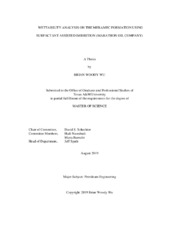| dc.description.abstract | Enhanced Oil Recovery (EOR) has been a popular topic as of lately with numerous field cases showing a higher recovery is achievable with the addition of certain chemical additives. This EOR refers to any method of trying to increase the volume of hydrocarbons that are produced by injecting chemicals to improve flow conditions for hydrocarbon production. Though this process is usually thought of as taking place after the completions operation is finished, surfactant addition to slickwater during hydraulic fracturing has been proven in many cases to increase the recovery factor when compared with slickwater/gel alone. Surfactants are now commonly used in all the major plays across the United States as operators are seeing higher recovery factors in comparison to wells on the same pad pumping only slickwater. This phenomenon can be described as the beginning phase of the EOR process that happens at the completions stage. Previous studies such as Alvarez et al. (2014) have shown the effectiveness of surfactant addition during hydraulic fracturing in tight liquid-rich carbonate and shale reservoirs, and its ability to shift the native wettability from oil-wet to water-wet. Other studies such as (SPE 189829) have shown that surfactants can assist flowback operations by decreasing pressure drop across the wellbore, reducing formation damage. All of this is only achievable through the application of the correct surfactant and concentration based on scientific experiments. Many different companies develop surfactant chemicals specifically tailored for oilfield application and choosing the correct type starts with proper classification. Surfactants are amphiphilic, meaning they have a polar head group and a hydrophobic tail.
A common method of classifying surfactants is according to the polar head group; these include cationic, anionic, and nonionic. Once the type of surfactant is chosen, the proper concentration is found through experimentation that favors the spontaneous imbibition of any residual oil, the process by which a wetting fluid, such as fracture fluid, is drawn into a porous medium by capillary action. It is also known that the addition of surfactants may not shift the native wettability, especially in native water-wet reservoirs, both of these topics are discussed in more detail in the Methodology section. These experiments and theories have been thoroughly tested on the Bakken, Eagle Ford, Wolfcamp, and Marcellus rocks by our laboratory, but have yet to be tried on the Meramec shale to this date. This study focuses on the data and materials taken from the Meramec formation in Kingfisher County, Oklahoma, more specifically the Rosemary 1-14H well. At the time of this project, there is little available information regarding the STACK Meramec, but production in this area is on the rise and getting notice amongst E&P companies looking to capitalize in a low market. The purpose of this study is to evaluate a change in contact angle (CA) and interfacial tension (IFT) that leads to wettability alteration, and the effect that certain types of surfactants have on these fluid properties. IFT and CA variation are measured in the presence of different types of surfactants at reservoir temperature and used in conjunction with spontaneous imbibition experiments to prove that wettability alteration is possible and could in some cases favor production. | en |


